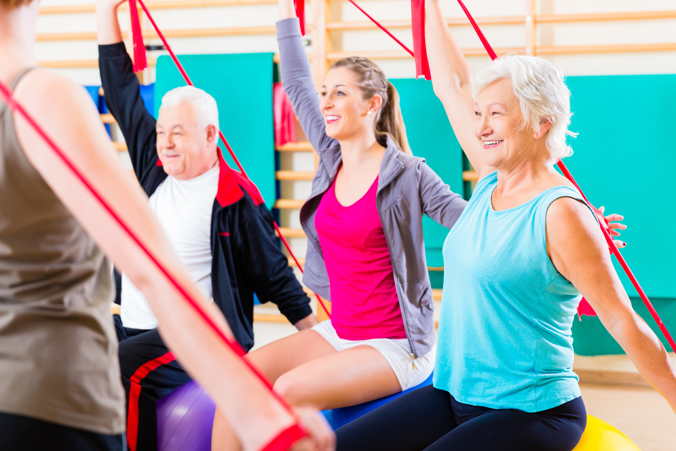CDC: US meets fitness goal, but more work needed
In the United States, 22.9% of adults aged 18 to 64 years met the federal leisure-time physical activity guidelines for both aerobic and muscle-strengthening activities in 2010-2015, according to a recent CDC and HHS report.
These guidelines recommend muscle-strengthening activities at least twice weekly, with either moderate-intensity aerobic physical activity for at least 150 minutes per week, vigorous-intensity aerobic physical activity for at least 75 minutes per week or an equivalent combination.
With nearly 23% of adults nationwide meeting the guidelines, a U.S. goal has been met 2 years ahead of time, according to Debra L. Blackwell, PhD, of the National Center for Health Statistics at the CDC.
“The Healthy People 2020 objective regarding physical activity specifies that 20.1% of all adults meet both aerobic and muscle-strengthening federal guidelines by 2020 — a truly positive finding,” she told Healio Family Medicine.
Despite the encouraging results, she said there is room for improvement.

“We obviously hope the 23% continues to go up and will continue to study this in future reports,” Blackwell said, adding that a deeper data dive shows that there is also more work to do in certain population groups.
“When we looked at differences by gender, we found that among all women aged 18 to 64, 18.7% met the guidelines through their leisure-time physical activity, which is nearly two percentage points lower than the Healthy People target.”
Conversely, 27.2% of men met the guidelines.
In addition, Blackwell and colleagues stated that 13 states had percentages that were significantly below the national average while 14 states and the District of Columbia had significantly higher percentages of adults meeting the guidelines than the national average.
The importance of exercise to avoid obesity is a long-standing tenet of healthy living, and recent data suggest new potential medical consequences to having obesity, such as a greater risk for influenza-related hospitalization, death due to CVD, cancer and other causes, and the possibility of diabetes in certain population groups.
The U.S. Preventive Services Task Force issued a draft recommendation earlier this year that clinicians with adult patients who have a BMI of 30 kg/m2 or more refer or offer intensive, multicomponent behavioral interventions including those that encourage exercise to that patient.
“Based on the research, we found that these interventions —which include a variety of programs that encourage healthy eating and exercise habits — are safe, effective and can help people with obesity improve their health,” task force chair and pediatrician David C. Grossman, MD, MPH, said in an interview.
The American Academy of Family Physicians has a blog and past issues of American Family Physician that offer recommendations on their respective websites to help facilitate discussions between primary care physicians and their patients regarding exercise:
- using the five A’s model — (Assess, Advise, Agree, Assist, Arrange) to provide brief messages to patients that are specific to their needs;
- setting achievable activity goals by telling the patient to start with activities he or she can realistically perform, especially in older patients;
- identifying barriers and offer potential solutions;
- providing specific recommendations on the frequency, intensity and type of activities;
- remembering the three components to fitness: strength, CV fitness and flexibility;
- encouraging the patient to ask questions and let clinicians know if they seriously injured themselves while exercising;
- emphasizing benefits that the patient cares about, then link the benefits with an increase in physical activity;
- increasing the patient’s self-motivation by suggesting that the patient help someone he or she cares about get physically active for health;
- reinforcing the benefits by asking the patient to consider other activities he or she enjoys to break up the monotony of the same exercise each day; and
- having the patient plan ahead for times when it might be more difficult to be physically active such as holidays, travel and vacations.
Patients also need to know that neither a lot of time nor a lot of expense is required to have a regular exercise routine, according to a blog on the AAFP website.
“If patients don’t have time or financial means to participate in organized sport or exercise, I often give them a practical walking prescription,” wrote Alex Mroszczyk-McDonald, MD, of the Kaiser Permanente network in Southern California.
“For example, I recommend parking at the far end of their parking lot, walking into work and taking the stairs for at least one or two flights. At lunch, they could walk 5 minutes away from their work environment, eat, then walk back. And at the end of the day, they would walk back to the car. I then suggest a 10-minute after-dinner walk with the family or dog. With minimal effort or expense, patients can build 30 minutes of walking into their daily routine.”
Once the patient has begun exercising, the AAFP’s website also encourages the physician to monitor the patient’s progress periodically at least annually, provide encouragement, and assist the patient in overcoming barriers such as fatigue or a lack of time. This is especially true in older patients, the website states. – by Janel Miller
References:
AAFP. Am Fam Physician. 2006;74:2095-2096.
Blackwell DL, et al. Natl Health Stat Report. 2018 Jun;(112):1-22.
Lee PG, et al. Am Fam Physician. 2017;95:425-432.
Meriwether RA, et al. Am Fam Physician. 2008;77:1129-1136.
Mroszczyk-McDonald A. Exercise is medicine. Here’s how I get patients started. AAFP Fresh Perspectives: New Doctors in Practice. May 16, 2018.
Disclosures: Healio Family Medicine could not confirm relevant financial disclosures at the time of publication.
